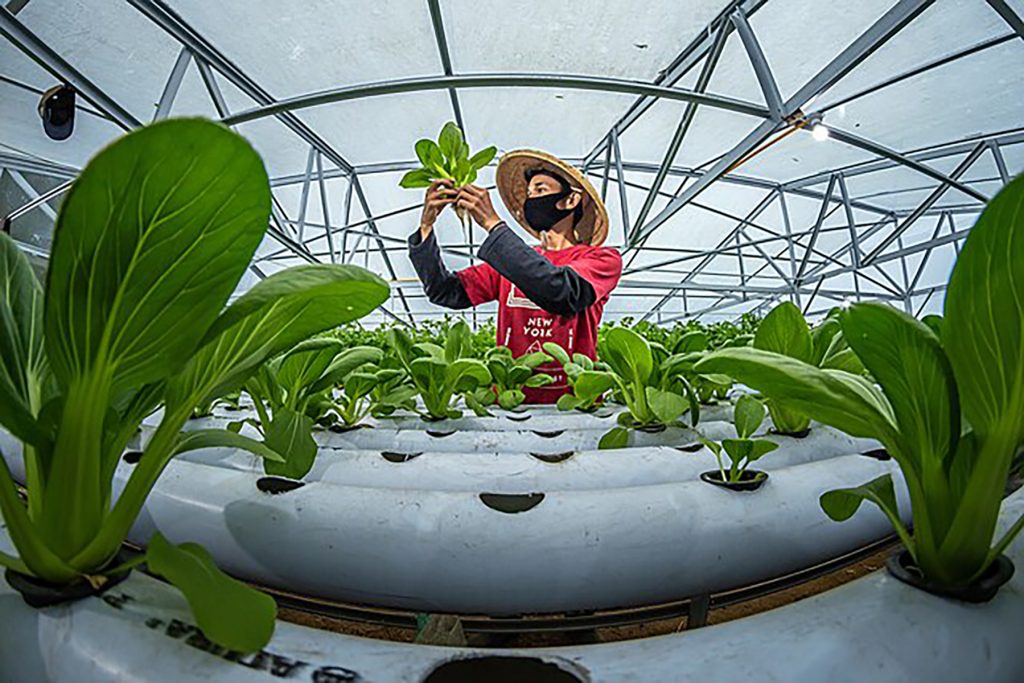
Hydroponics is the art and science of growing plants without soil. Instead of soil, some inert substrate, such as vermiculite, a naturally occurring mineral made of magnesium, aluminum, and iron silicate is used. The vermiculite – which are particles of mica – anchors the plant roots while water containing fertilizer and other nutrients circulates in the grow medium.
People often think of hydroponics as a new technology. The first mention of hydroponics, or growing plants without soil was in the 1627 book Sylva Sylvarum or ‘A Natural History‘ by Francis Bacon. During the 19th century, people dabbled with hydroponics more or less as a hobby or curiosity. It was not until the 1930s that people figured out how to use hydroponics to grow plants on a commercial scale. One of the first successful applications of commercial-scale hydroponics took place on Wake Island, a small rocky atoll in the Pacific Ocean, where there was a refueling stop for Pan American Airlines. Hydroponics was used on Wake Island in the 1930s to grow vegetables to feed airline passengers. Hydroponics was the only way to grow vegetables on Wake Island because there was no soil available. It was way too expensive to airlift fresh vegetables to the island. Human nature being what it is, inevitably, people figured out how to use hydroponics to grow cannabis. It is not clear when the first applications of hydroponics to grow cannabis happened. But it happened. Growers grow. Especially cannabis growers.
Today, hydroponic growing is a huge part of the ecology of cannabis growers. My problem is that except for growing bean sprouts in milk cartons packed with vermiculite back in fifth grade. I know virtually nothing about hydroponics. Because I am a tyro when it comes to hydroponics, I thought it wise to approach this world from the perspective of professionals. Ocean State Hydroponics in Westerly is a veteran of the hydroponics grow scene. I interviewed Rafael Cortez and Scott Slagel of Ocean State Hydroponics to get an entry-level perspective on this fascinating grow technology. Responses have been lightly edited for clarity and length.
Brennan (Motif): How long has Ocean State Hydroponics been in business?
Rafael Cortez (RC): Ocean State Hydroponics has been around for five years in its present form. We have been in the Mill Pond Plaza in Westerly for ten-plus years. The store was formerly Grow RI and operated out of a 1,700-square-foot space until I acquired it in 2018. By 2020 I understood we needed more space, so I moved the store to our current 4,500 square foot location.
LB: Who are your customers/clientele?
RC: Our clientele ranges from 30-year-olds to the elderly and from beginner growers to small-scale cultivation. All sorts of people walk through our doors. Our customers range from people looking to grow veggies to reduce their food costs to the person who wishes to grow cannabis. We try to help everyone who comes into our store.
LB: Has Ocean State Hydroponics changed its business model in relation to the legalization of cannabis in Rhode Island?
RC: No. The Ocean State Hydroponics business model has always been to help people grow healthy plants.
LB: Why is hydroponic technology an effective way to grow weed?
RC: The simple answer is soil. In soil, one cannot monitor the root systems. In hydroponics, the roots and all parts of the plant are accessible.
LB: There are cannabis growers who claim that a “living soil” approach to growing cannabis is better than hydroponics. Can you comment on this philosophy?
Scott Slagel: Soil has a more biologically diverse environment than hydroponics. Bacteria, microbes, and fungi play a huge part in terpene production (the compounds that give cannabis flowers those unique fragrances). Hydroponics works best in clean, bacteria, fungi, and microbe-free environments.
LB: What can the home grower do to optimize the production of their personal cannabis supply?
RC: Step 1: Stop telling yourself you have been growing for x number of years and don’t need to change. Step 2: Don’t grow 25 different strains. Even if seeds come from the same genetic source, they can express major differences. Step 3: Cleanliness is Godliness. Dirty rooms attract pests such as rotifers, molds, fungi, rust, and mildew. Step 4: Keep a journal. When changes are made, note them. Step 5: Know your grow. Getting your environment right (lights, temps, humidity). Step 6: DO NOT CUT CORNERS. Step 7: Never be afraid to talk to other experienced growers. (The internet can be a great source of information if you are educated enough to navigate the BS.) Step 8. Patience. This is the hardest step. Plants can’t be rushed. Making corrections to problems during a grow can often take several days.
LB: Thank you, Rafael and Scott. Your insights help growers grow. Especially home growers. Motif readers, if you are in Westerly and are interested in any or all things hydroponics – cannabis or otherwise – visit Ocean State Hydroponics. I learn something new every time I walk through their door. •
Ocean State Hydroponics is located at 105 Franklin Street Unit 38, Westerly, RI 02891, (401) 596-0904, Oceanstatehydroponics@gmail.com